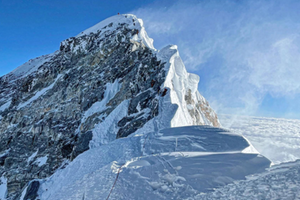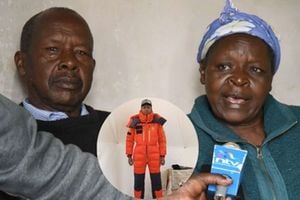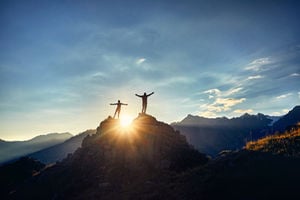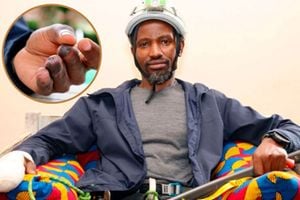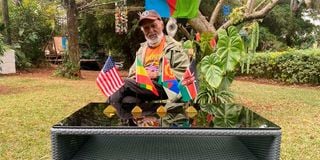
Mountaineer Naigzy Gebremedhin during the interview at his home in Peponi in Westlands, Nairobi on September 28, 2024.
Eritrean Naigzy Gebremedhin has lived in Kenya for 51 years and may be the holder of the longest permanent residency in the country.
What’s not in doubt is the fact he is the oldest man to climb Mount Kenya, the tallest mountain in Kenya and second tallest in Africa.
Naigzy has reached Point Lenana 14 times. He celebrated his 90th birthday on top of the sixth highest peak in Africa on August 12 this year to remain the oldest person to have made such an ascent on Mt Kenya
Naigzy completed his 13th ascent six years ago at the age of 84 when he set the record as the oldest man to reach point Lenana.
But, how did all this mountain climbing journey start? Was there motivation behind it? Why climb one peak 14 times? Are there cost implications? At least 150 people are believed to have died ascending Mount Kenya since 1985, so is he not afraid of becoming a statistic too?
The writer meets Naigzy at one of his homes in Peponi, Westlands in Nairobi for answers.
“Kilimanjaro was the mountain that aroused my passion for mountain climbing. It was all unplanned and spontaneous,” Naigzy cheerfully volunteers.
Kenya was still a British colony when Naigzy started mountain climbing in 1959.
“I was a junior lecturer at the Building College which was part of Emperor Haile Selassie I University in Addis Ababa. I had not reached 25 years. A Swedish architect, who was the Dean of the Building College, invited me to join him and his family as they planned to drive from Addis Ababa to Nairobi and then Mombasa for their holiday,” says Naigzy.
At the time, Kenya was in a state of emergency arising from the Mau Mau rebellion against British rule and travelling was strictly controlled. “We made it to Marsabit after a gruelling 15 days of driving from Addis Ababa,” observes Naigzy, adding that the colonial authorities at the border checkpoint were not enthused “with this little black man” in the company of a white family.
Nonetheless, they reluctantly gave him an entry pass. His white colleagues could stay in hotels, while he was not allowed and so he had to sleep in the van.
“We made it to Nairobi and my colleagues were allowed to stay at the Queens Hotel which I believe is now called 680 Hotel. I was told to find accommodation in the native quarter. I had to do that before the curfew hour came into force at 6pm. I finally found a hotel room on Grogan Road, the current Ngara area,” narrates Naigzy.
But he did not travel with his colleagues to Mombasa.
“It would have been more humiliation trying to find accommodation close to them,” said Naigzy who decided to travel to Tanganyika which was a German protectorate.
So, why Tanganyika? He had an old friend Pastor Ephraim Amos Lemu that he had known from his college days.
“Ephraim was from a small village in the foothills of Mount Kilimanjaro called Marangu, so I travelled there by bus and I was warmly welcomed by my friend. One had the most captivating view of the snow-capped mountain from Marangu. I was mesmerized by the view of the snow covered peak and asked Pastor Ephraim to help me climb the mountain.”
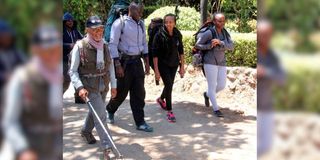
Naigzy Gebremedhin (left) leads a team of climbers as they start their ascent of Mt Kenya from Naromoru River Lodge on August 10, 2018. This was Naigzy's 13th climb of Mt Kenya.
Naigzy insisted on climbing the mountain even after his friend had told him that he was not prepared. Ephraim got him the best guide, one that he says was nurtured by the famous pioneer mountaineers Yohanna.
The mountain climbing gear consisted of a leather jacket, a towel around his head and a baseball cap. He wore two pairs of pants. He also borrowed a set of woollen gloves.
“I made it to the top in record time of about two to three days,” says Naigzy.
But he exposed himself to great danger. “I lost all the skin on my face. After returning from the top, I slept for more than two days.
The people taking care of me thought I was dying. Now and then they would come and shake my shoulders trying to see if I was alive!”
His love for mountain climbing had started.
Naigzy has climbed Kilimanjaro four times in 55 years.
He has also reached minor peaks in Ethiopia, New Zealand, the USA, Switzerland, Spain, Argentina and Brazil.
How does Naigzy prepare to conquer a mountain? “First and most important is to be psychologically prepared. I believe in divine protection, too. I humbly pray and ask God for guidance and support. I pack essentials. I ensure I have a good pair of boots. No skimping on that item,” says Naigzy.
“I have my sleeping bag carefully selected. It is light, but fully able to protect or comfort me against cold and wind,” he continues, adding that he carries adequate water. “But in the final analysis, let me say it is not a physical or material thing. It is sheer tenacity.
Not giving up. Just go on, and on,” he says gently.
“I celebrated my 25th birthday at the top of Kilimanjaro,” said Naigzy who climbed Kilimanjaro again in 1984 when he turned 50, in 2010 when he was 76 and in 2014 when he turned 80.
From his experience, climbing Kilimanjaro at an early age, Naigzy says Mount Kenya was not a serious challenge.
“I have little recollection about the early climbs of Mount Kenya. I must confess that over the years the climb of Mount Kenya has become increasingly challenging. I feel that that is because the route is not maintained. There is much deterioration to the detriment of the climber, especially the inexperienced climber,” Naigzy points out.
What does his family think about his mountaineering escapades?
“I suspect my brothers and sister, who are all in their 80s now, have slight misgivings and so did my late parents, aunts and uncles. My parents were a bit sceptical of my mountaineering adventures,” says Naigzy, who was a champion boxer for his age group while in high school.
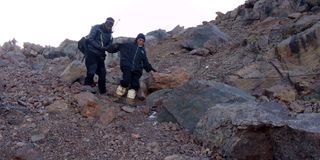
Guide Boniface Maina (left) assists Naigzy Gebremedhin as he descends from Lenana point of Mt Kenya on August 21, 2016.
He says they thought that climbing a mountain was an act lacking decorum, somewhat unfit for the gentlefolk.
“An exception is my daughter Marta, a high school teacher who is now over 50 years old and a mother of three boys. She is an avid hiker, travelling with her husband in the remote parts of America carrying huge backpacks. She was with me this August when I climbed Mount Kenya to celebrate my 90th birthday. Not only that, she brought two of her three sons Daniel and Micah to climb with me. They made it to the top easily, so did my son’s son Noah,” says Naigzy.
He has used the Naro Moru route 14 times.
“I have never been to the other two summits -- Batian and Nelien. Climbing these two summits requires sophisticated technical mountain climbing skills which I do not have,” admits Naigzy.
He adds that during his younger days he could do the entire Point Lenana ascent over a weekend.
“I would leave Nairobi very early on a Saturday morning, drive to Naro Moru River Lodge, have very early breakfast, drive to Met Station and leave the car there. I would rapidly walk up to Mackinders hut and rest there until midnight Saturday and climb up to Point Lenana, reaching it at sunrise on Sunday and returning to Naro Moru River Lodge by noon. Then the same day Sunday, I would drive back to Nairobi getting home before dark,” he says.
Naigzy, who worked at the United Nations headquarters in New York, USA for four years and at the United Nations Environment Programme headquarters in Nairobi for 23 years, says his best moment was climbing Mount Kenya was in 1986.
“I did so under the leadership of Kenneth Matiba, an accomplished hiker. He led scores of us to the top, many who had no previous experience in hiking or climbing. He was a true leader. He made sure everyone of us got to the top,” says Naigzy who got his Bachelor of Science in Civil Engineering from Kansas State University and Master of Science in Architecture and City Planning from Massachusetts Institute of Technology in the USA.
He adds: “I remember him telling me, Gebremedhin, remember this is a team effort. Stay with the team.”
Naigzy says he suspects that Matiba noted his preoccupation to show off and was gently warning him to go easy.
His worst moment was around 2003-2004 when darkness set in as he was climbing.
“I remember I was attacked by a Cape buffalo, but luckily managed to escape without any injury. You see after darkness, the buffaloes congregate onto the path. It is their night abode. After dark, they do not like anyone infringing on their territory. I was lucky to have an experienced guide Charles*.
"He told me to make as much noise as possible. So both of us ran down the gate shouting loudly until we almost lost our voices. The experienced guide told me that buffaloes do not like noise. As long as we made a lot of noise, they stayed out of our way and so we arrived safely at the gate. But, it was my most harrowing experience,” said Naigzy.
Naigzy has lived in Kenya since 1973, but he is not a Kenyan citizen. “I’m a permanent resident. I have been here for more than half a century. I tried once to get citizenship, but it got too complicated. It did not work out, but I’m happy as a permanent resident,” notes Naigzy.
What he loves about Kenya is the amazing landscape, climate, weather and kind people. “Kenyans are humble without being subservient. They are accommodating of strangers. I’m also amazed by how quickly modern technology is adopted nationwide. Nationwide use of Safaricom M-pesa is an example. Kenya has even introduced it to its neighbour, Ethiopia,” says Naigzy.
Kenya’s preoccupation with education and education excellence is also something he likes about the country-.
“I am amazed how much educational achievement is celebrated. Sample exam papers are published in leading newspapers. I have been to more than 100 countries. I know nowhere else where this happens. Students who do well are nationally recognized and celebrated.”
Naigzy can speak fluent English, Amharic and Tigrinya, less fluently Swedish, French and Italian. “Sadly, I have only a smattering of Swahili,” he says.
“Are you through with climbing now?
“No, hapana,” he replies smiling.

